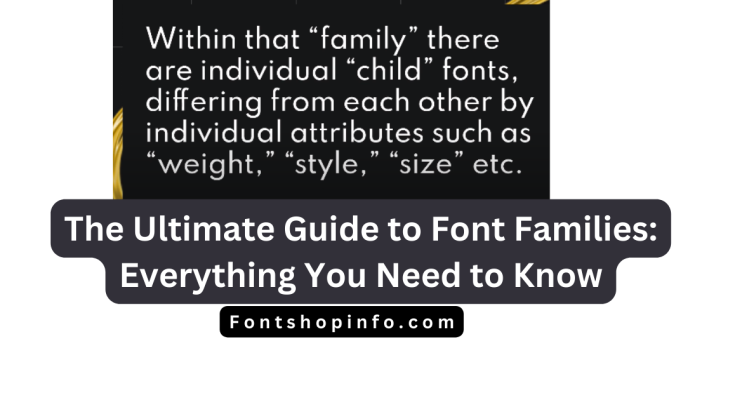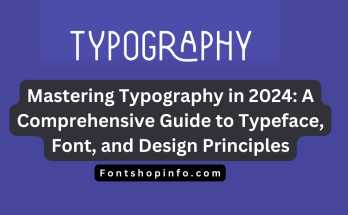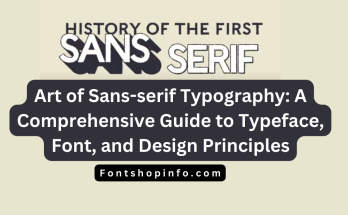Font Families

Font families are essential in determining the visual identity of material in the field of design and aesthetics.
Font families are the fundamental units of typography, ranging from the classic beauty of Serif to the contemporary minimalism of Sans-serif and the creative flare of Script.
Mastering Typography in 2024
We will examine the subtleties, classifications, and effects of font families on different design aspects as we dig into the intriguing world of font families in this piece.
Understanding Font Families

A font family is essentially a collection of linked fonts with similar design elements.
These features, which can vary in weight, style, and structure, give designers a flexible arsenal with which to express their ideas.
A font family’s uniqueness is mostly influenced by its typeface, font style, and weight.
Serif and Sans-serif Distinction

Within font families, serif and sans-serif constitute two main groups. Serif typefaces give off an air of formality and history because of their little ornamental lines at the ends of their strokes.
Sans-serif typefaces, on the other hand, communicate a contemporary, uncluttered look when they lack these frills.
When deciding between these two very different styles, it is important to consider the tone and intent of your text.
Exploring Script and Display Fonts

Script typefaces give a design a subtle, individualized touch by imitating cursive handwriting. Display typefaces are designed to make a strong impression and are frequently used for headlines and logos.
Strategically using Script and Display typefaces can improve your project’s visual appeal.
Monospace for Clarity

Monospace fonts provide consistency in width by allotting the same amount of space to each character. Monospace typefaces are frequently used in coding and programming to improve readability and accuracy.
When determining if the organized format of Monospace is appropriate for your material, take into account its nature.
Font Attributes and Customization

Font size and weight are important characteristics that affect your text’s readability and style. By modifying these characteristics, you may establish hierarchy and focus in your material.
Additionally, designers may modify typefaces to match project themes or brand identities with the use of font editing tools.
Web Fonts and Accessibility

Web fonts are a notion that the digital environment brought, enabling websites to employ a wider variety of fonts than those available through the normal system settings.
Popular options for online typography are Google typefaces and Adobe Fonts, which offer an extensive collection of typefaces that improve the user experience on the whole.
Accessibility is important since it guarantees that the typefaces selected are legible on a variety of platforms and devices.
Font Classification and Hierarchy

Fonts can be arranged according to their intended usage with the help of font categorization, which includes groups like display, text, and script.
By defining a typeface hierarchy, you may help the reader navigate the information, highlight important details, and preserve visual consistency.
Innovations in Font Technology

A significant advancement in font technology is the introduction of changeable fonts. Multiple styles can be contained in a single file with variable fonts, facilitating smooth transitions between various weights and styles.
This invention helps to improve web page loading speeds while simultaneously increasing design flexibility.
Font Management and Licensing

Effective font management entails putting fonts in order and classifying them for convenience of use. Complying with use limits requires understanding font licensing.
Common font types OpenType and TrueType both have their own advantages and capabilities.
Conclusion
To sum up, font families are the foundation of good typography since they provide designers with a wide range of colors to use when communicating ideas effectively and stylishly.
Designers may produce harmonies that speak to their target audience by learning the subtleties of serif, sans-serif, script, and other font types.
With developments like changeable fonts, font technology is always evolving, giving designers even more freedom to express their ideas.
Accept the variety of font families, try out various pairings, and allow your typography to convey an engaging visual narrative.
FAQ
What is a font family?
A font family is a collection of related fonts that share design elements. These elements, including style, weight, and typeface, offer designers a versatile toolkit for expressing their ideas creatively.
What influences the uniqueness of a font family?
A font family’s uniqueness is primarily influenced by its typeface, font style, and weight. These variations allow for a wide range of creative expression in design.
What distinguishes Serif and Sans-serif fonts?
Serif fonts feature small ornamental lines at the ends of strokes, exuding formality and a historical feel. In contrast, Sans-serif fonts convey a contemporary and uncluttered appearance by lacking these decorative elements.
How do I choose between Serif and Sans-serif for my project?
Consider the tone and intent of your text. Serif fonts are often associated with tradition and formality, while Sans-serif fonts offer a more modern and clean look.
What characterizes Script and Display typefaces?
Script typefaces mimic cursive handwriting, providing a personalized touch to designs. Display typefaces are designed to make a strong impression and are commonly used for headlines and logos.
How can Script and Display fonts enhance my project’s visual appeal?
Strategically using Script and Display fonts can add a unique touch and grab attention, improving the overall visual impact of your project.
In what contexts are Monospace fonts beneficial?
Monospace fonts, by allocating the same space to each character, enhance consistency and are often used in coding and programming for improved readability and accuracy.
How do I determine if Monospace is suitable for my content?
Consider the nature of your material. Monospace is particularly effective for organized and structured content, such as code.
How do font size and weight impact readability and style?
Font size and weight are crucial for establishing hierarchy and focus in your material. Modifying these attributes allows for customization to match project themes or brand identities.
What tools can be used for font customization?
Designers can use font editing tools to modify typefaces and customize them according to the specific requirements of their projects.
What are web fonts, and why are they important?
Web fonts allow websites to utilize a broader range of fonts than those available through standard system settings. Popular options like Google typefaces and Adobe Fonts enhance the overall user experience.
Why is accessibility crucial in font selection?
Accessibility ensures that selected typefaces are legible on various platforms and devices, catering to a diverse audience.
How can fonts be organized for effective usage?
Font categorization, including groups like display, text, and script, helps arrange fonts based on their intended usage. Establishing a typeface hierarchy aids in guiding the reader, highlighting key details, and maintaining visual consistency.
What is the significance of variable fonts?
Variable fonts allow multiple styles to be contained in a single file, enabling smooth transitions between different weights and styles. This innovation enhances web page loading speeds and provides designers with greater flexibility.
What is effective font management, and why is it important?
Effective font management involves organizing and categorizing fonts for ease of use. Understanding font licensing is essential to comply with usage limits. Common font types, such as OpenType and TrueType, offer distinct advantages.



